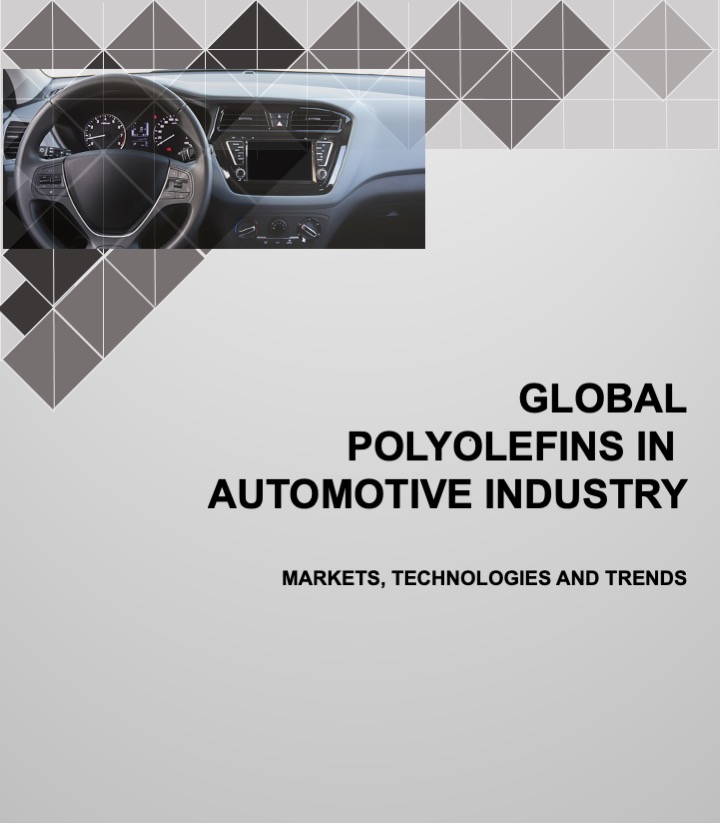Polyolefins in Automotive Markets
The global automotive industry is one of the most important sectors of economic growth and revenue. The US was once the largest producer of automotive parts globally until it was overtaken by China in 2008. The percentage of plastics used in vehicles has increased significantly, and polyolefins are the preferred type of plastic used in automotive manufacture. Polypropylene (PP) is the most commonly used polyolefin in automotive applications due to its good impact strength, low density, excellent processability, mechanical properties, and good dimensional stability. Polyethylene (PE) is also used in automotive applications but to a lesser extent. In addition to polyolefins (PP and PE), elastomeric polyolefin technologies used in automotive applications include several categories of thermoplastic elastomers (TPEs). TPEs are thermoplastics with rubber-like properties that provide flexibility and impact strength. A significant category is thermoplastic polyolefin elastomers (TPE-O), more often called thermoplastic polyolefins (TPOs). Conventional TPOs are two-phase, physical blends or compounds of polypropylene (PP) with an elastomeric phase (EPDM or an elastomer) that is more than 20% by weight. A newer category is reactor-made TPOs (R-TPOs). Another category of TPEs is thermoplastic vulcanizates (TPVs), which are alloys of EPDM rubber particles in a PP matrix. Styrenic block copolymers (TPE-S) are another category. The main focus of the report is on passenger cars and light trucks. Parts made of polyolefins are divided into three categories: interior parts, exterior parts, and under the hood parts.
Market Drivers in the Global Polyolefin Automotive Market
The main reasons for the use of plastics in the automotive industry are weight reduction (“lightweighting”), which leads to higher fuel efficiency and greenhouse gas reductions. With the move to electric vehicles (EVs), lightweighting continues to be important. TPOs have gained increasing acceptance over other competing materials because of the global trend towards homogenization of materials usage in automotive interior and exterior applications. The volume of vehicle production affects the volume of polyolefins used. The exhibit below shows historical global passenger car production from ADI CMR archives. Car production in 2020 and 2021 was affected by the pandemic and supply-chain issues, but it is expected to continue to grow. ADI CMR follows the automotive market closely. In June 2020, ADI Analytics reported that in China, EVs are growing and are expected to continue to take an increasing share of the passenger vehicle market. ADI reported in March 2021 that EVs in North America, particularly in passenger cars, are expected to grow at 25-30% per year through 2030.

Exhibit 1. Global passenger car production in millions
Global Polyolefin Automotive Market Assessment
ADI Chemical Market Resources (ADI CMR), with extensive experience in these technologies, has conducted a strategic analysis that covers all major developments in the industry including a comprehensive analysis of supply-demand balance, status of technology availability, and strategic partnerships. It also gives extensive coverage on emerging players and challenges. Our in-depth examination and methodology are designed to assist companies in monitoring the rapid developments, analyzing the trends, and capitalizing on the many opportunities in these changing markets and technologies. The report is based on thorough analysis of the industry through a wide range of methods, including published information, patent searches, ADI CMR proprietary projects, and interviews with leading polyolefin suppliers and distributors, as well as interviews with major compounders and end users to understand their current and unmet needs. The manufacturing cost economics based on our extensive cost databases and interviews. The report will particularly benefit present and future polyolefin automotive market participants; polyolefin producers, compounders, and end users; other polyolefin industry participants; and individual end-users, entrepreneurs, and organizations attempting to understand these complex issues and capture future growth in the marketplace.
Table of Contents
Click here to view the table of contents for this report.
Prospectus
Please fill this form and check your email for a link to download the prospectus. For a custom report on a topic of your choice or an updated version of an existing report, please contact us at +1 (281) 506-8234 or info@adi-cmr.com.


